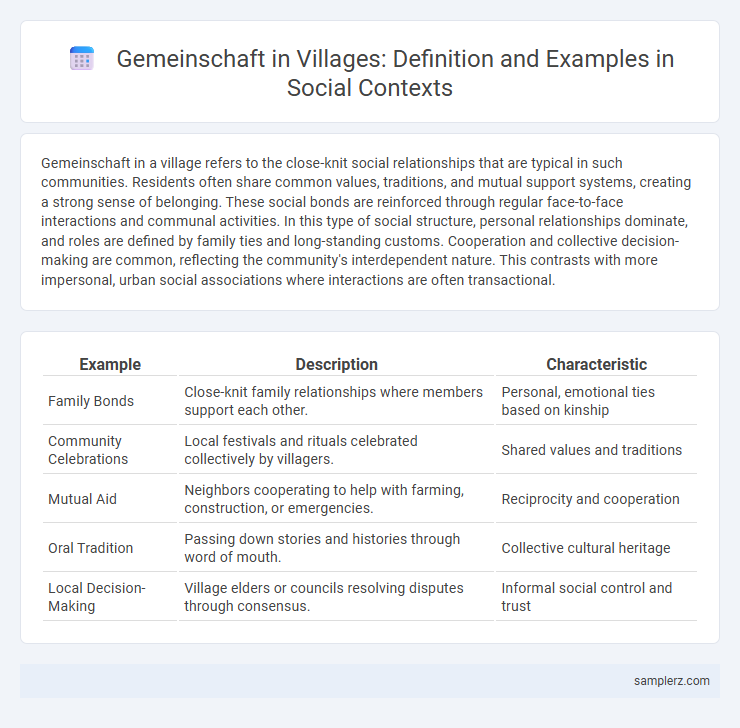Gemeinschaft in a village refers to the close-knit social relationships that are typical in such communities. Residents often share common values, traditions, and mutual support systems, creating a strong sense of belonging. These social bonds are reinforced through regular face-to-face interactions and communal activities. In this type of social structure, personal relationships dominate, and roles are defined by family ties and long-standing customs. Cooperation and collective decision-making are common, reflecting the community's interdependent nature. This contrasts with more impersonal, urban social associations where interactions are often transactional.
Table of Comparison
| Example | Description | Characteristic |
|---|---|---|
| Family Bonds | Close-knit family relationships where members support each other. | Personal, emotional ties based on kinship |
| Community Celebrations | Local festivals and rituals celebrated collectively by villagers. | Shared values and traditions |
| Mutual Aid | Neighbors cooperating to help with farming, construction, or emergencies. | Reciprocity and cooperation |
| Oral Tradition | Passing down stories and histories through word of mouth. | Collective cultural heritage |
| Local Decision-Making | Village elders or councils resolving disputes through consensus. | Informal social control and trust |
Traditional Family Bonds in Village Life
Traditional family bonds in village life exemplify gemeinschaft through strong, enduring relationships rooted in kinship and shared cultural practices. Multi-generational households foster mutual support, collective decision-making, and the preservation of customs that reinforce social cohesion. These intimate family networks contribute to the village's social fabric by emphasizing loyalty, responsibility, and face-to-face interaction.
Cooperative Farming Practices among Villagers
Cooperative farming in villages exemplifies Gemeinschaft through shared labor, resources, and decision-making among villagers, strengthening social bonds and collective well-being. This practice enhances crop yields and sustainability by pooling tools, seeds, and knowledge while fostering trust and mutual support. Villagers' interdependence in cooperative farming reflects traditional communal values that prioritize group harmony over individual profit.
Intergenerational Households and Support Systems
Intergenerational households in traditional villages foster strong social cohesion by enabling multiple generations to live under one roof, promoting shared responsibilities and mutual support. These living arrangements enhance the transfer of cultural values, wisdom, and caregiving roles, strengthening community bonds across age groups. Support systems within such communities often include collective childcare, eldercare, and resource pooling, reflecting the core principles of Gemeinschaft social organization.
Collective Decision-Making in Local Council Meetings
In village communities, gemeinschaft is exemplified through collective decision-making in local council meetings where residents prioritize shared values and communal well-being. Discussions often reflect strong interpersonal relationships, emphasizing consensus and mutual support rather than individual interests. This process strengthens social cohesion and ensures that decisions align with the community's collective needs and traditions.
Rituals and Festivals Strengthening Social Cohesion
In small villages, gemeinschaft manifests clearly through rituals and festivals that strengthen social cohesion by fostering a shared sense of identity and belonging. Traditional celebrations such as harvest festivals and seasonal rituals encourage collective participation, reinforcing bonds among community members and preserving cultural heritage. These events create opportunities for intergenerational interaction and mutual support, essential for maintaining cohesive rural societies.
Neighborly Reciprocity and Mutual Aid
Village communities exemplify gemeinschaft through neighborly reciprocity, where residents routinely exchange goods and services to support each other. This mutual aid fosters strong social bonds and a shared sense of responsibility, enhancing community resilience. Regular cooperation in daily tasks such as farming, childcare, and maintenance sustains interconnected relationships crucial for communal well-being.
Shared Religious Beliefs and Community Worship
In many villages, gemeinschaft is exemplified through shared religious beliefs that unify residents around common values and traditions. Community worship services often serve as central social gatherings where trust, mutual support, and collective identity are reinforced among villagers. Such practices strengthen social bonds and foster a sense of belonging crucial for maintaining close-knit, cooperative communities.
Informal Social Norms Guiding Village Behavior
In traditional villages, gemeinschaft is exemplified through informal social norms that guide behavior such as mutual aid, trust, and communal decision-making. Residents typically follow unwritten rules like sharing resources during festivals and resolving conflicts through elders' mediation, reinforcing strong social cohesion. These norms foster a sense of belonging and collective responsibility, ensuring village harmony and continuity.
Social Control through Gossip and Reputation
In traditional villages, social control is maintained through the practice of gossip, which rapidly disseminates information about individuals' behavior and reinforces community norms. Reputation acts as a powerful mechanism, influencing social standing and encouraging conformity to shared values within the Gemeinschaft. This informal system ensures accountability and cohesion by leveraging collective awareness and mutual monitoring.
Birth, Marriage, and Funeral Ceremonies as Communal Events
Birth, marriage, and funeral ceremonies in a village exemplify gemeinschaft by fostering strong communal bonds through shared traditions and collective participation. These events often involve extended family, neighbors, and community members who contribute to rituals, reinforcing social cohesion and mutual support. Such ceremonies highlight the interconnectedness of individuals within the village's social fabric, emphasizing collective identity and cultural continuity.

example of gemeinschaft in village Infographic
 samplerz.com
samplerz.com